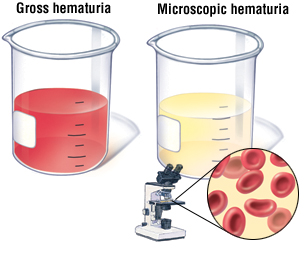Types Of Microscopic Hematuria
Gross hematuria is when you can visibly see the color red or possibly other shades in your urine. The urine may look pinkish brownish or bright red.
 Glomerular Hematuria With 60 Dysmorphic Rbcs In A Patient With Suspected Infection Medical Laboratory Medical Laboratory Science Medical Laboratory Scientist
Glomerular Hematuria With 60 Dysmorphic Rbcs In A Patient With Suspected Infection Medical Laboratory Medical Laboratory Science Medical Laboratory Scientist
Due to staghorn calculi calcium stones or uric acid stones.

Types of microscopic hematuria. Dysmorphic erythrocytes from a urine specimen. Even if your bleeding was discovered through urine testing urinalysis youre likely to have another test to see if your urine still contains red blood cells. If you can see the blood in your urine it is called gross hematuria.
Both types of hematuria are taken seriously and a complete workup may be required. So can Alport syndrome which affects the filtering membranes in the glomeruli of the kidneys. If you cannot see the blood in your urine without looking at it under a microscope it is called microscopic hematuria.
There are two types of hematuria which include. Mineral imbalances in the urine. In some cases no cause of.
Inflammation of the kidney urethra bladder or prostate in men Abnormal structures in the urinary tract. Due to IgA. Inherited diseases like polycystic kidney disease sickle cell disease or hemophilia.
There are two types. There are two types of hematuria Gross hematuria means that the blood can be seen by the naked eye. These cells suggest a glomerular cause of microscopic hematuria.
Gross hematuria - may appear smoky tea-colored or bloody. Physical exam which includes a discussion of your medical history. As such the patient can detect that there is blood in their urine Microscopic hematuria - In this case the patient may not be able to tell that there is blood in the urine which means that its asymptomatic.
Phase contrast microscopy 100 Dysmorphic erythrocytes are characterized by an. Sickle cell anemia a hereditary defect of hemoglobin in red blood cells causes blood in urine both visible and microscopic hematuria. The two types of hematuria are gross hematuriawhen a person can see the blood in his or her urine microscopic hematuriawhen a person cannot see the blood in his or her urine yet it is seen under a microscope The male and female urinary tracts.
Prevalence of Urinary Tract Malignancies. Todenhofer T Hennenlotter J Tews V et al. There are two types of hematuria.
Advances in medical imaging for the diagnosis and management of common genitourinary cancers. It is defined as three or more red blood cells per high-powered field. A special tool such as a cytoscope or an.
Some of the most common causes of blood in the urine include. This is like an X-ray that looks at your kidneys and bladder. Often however the urine appears completely normal because there is not enough blood to cause a color change.
A magnetic resonance imaging MRI test. A computed tomography CT scan. In this case the condition is called microscopic hematuria.
Due to pyelonephritis cystitis or urethritis. There are actually two types of hematuria. If there are enough red cells the urine can become bright red pink or cola colored.
Impact of different grades of microscopic hematuria on the performance of urine-based markers for the detection of urothelial carcinoma. Rather it requires microscopic examination for detection. Microscopic hematuria means that the urine is clear but blood cells can be seen when urine is looked at under a microscope or tested in a lab.
The most common causes of microscopic hematuria are urinary tract infection benign prostatic hyperplasia and urinary calculi. Although the hematuria guidelines panel noted nonlife-threatening diagnoses eg benign prostatic hypertrophy 129 and urethral stricture 14 can be discovered during a microscopic hematuria evaluation 3 such conditions are not common to or relevant for women. Hematuria is the presence of red blood cells in the urine.
The following tests and exams play a key role in finding a cause for blood in your urine. Microscopic hematuria associated with proteinuria suggests glomerular disease and requires further investigation as an outpatient CBC - for anemia and thrombocytopenia. Bagheri MH Ahlman MA Lindenberg L et al.
Microscopic hematuria is when the blood in your urine can only be seen under a microscope. Due to pelvic trauma renal injuries or foreign bodies. Though only gross hematuria is noticed without lab testing both can be signs of a larger issue.
Initial hematuria Blood at beginning of micturition with subsequent clearing. It is not visible to the naked eye. The medical name for blood in your urine is hematuria.
Microscopic hematuria requires medical testing for detection. Gross hematuria is when blood is clearly visible and can be an alarming sight. Another method for detection of microscopic hematuria is the dipstick method.
Microscopic hematuria is when there are red blood cells in the urine that can not seen with the naked eye but visible under microscopy.

 Workup Of Microscopic Hematuria Province Of British Columbia
Workup Of Microscopic Hematuria Province Of British Columbia
 Racgp Macroscopic Haematuria A Urological Approach
Racgp Macroscopic Haematuria A Urological Approach
 Evaluation Of Asymptomatic Microscopic Hematuria In Adults American Family Physician
Evaluation Of Asymptomatic Microscopic Hematuria In Adults American Family Physician
 Approach To Microscopic Hematuria Springerlink
Approach To Microscopic Hematuria Springerlink
 Glomerular Hematuria Phase Contrast X400 Urinarysediment Urine Nephrology Nephpearls Kidney Renal Foame Microbiology Lab Medical Laboratory Laboratory
Glomerular Hematuria Phase Contrast X400 Urinarysediment Urine Nephrology Nephpearls Kidney Renal Foame Microbiology Lab Medical Laboratory Laboratory
 Medical Student Curriculum Hematuria American Urological Association
Medical Student Curriculum Hematuria American Urological Association
 Does Microscopic Hematuria After Pediatric Blunt Trauma Indicate Clinically Significant Injury Journal Of Surgical Research
Does Microscopic Hematuria After Pediatric Blunt Trauma Indicate Clinically Significant Injury Journal Of Surgical Research










